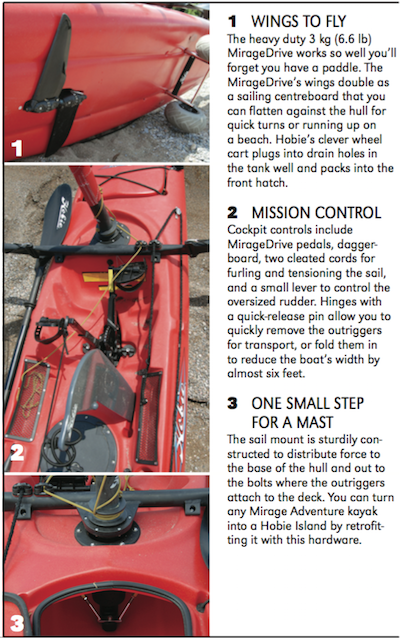BEFORE YOU ASK what business this crazy contraption has in a kayak review, let me explain that the core of the Hobie Island sailing trimaran is a standard Hobie Mirage Adventure sit-on-top kayak (this boat’s full name is the Hobie Mirage Adventure Island). The Mirage Adventure is the fastest kayak in the Hobie lineup, designed for maximum speed, tracking and carrying capacity. So if you strip off the Island’s pedal drive, plug-in wheelie cart, twin outriggers, 15-foot mast and 54.5-square-foot sail, you’re left with this nice all-purpose kayak to paddle around or fish from. It even has three hatches and built-in fishing rod holders.
A cautious kayaker, I first climbed aboard the Island with my paddle firmly in hand, ready to resort to paddling if things went sideways. Pedaling with my feet, controlling the rudder with my left hand and working the two lines for the sail with my right felt a bit like learning to fly a helicopter at first. But within half an hour playing in moderate winds I went from complete sailing beginner to flying along at up to seven knots. When the wind died or I stalled trying to come about to tack, I simply threw in a few pedal strokes to get moving again. I had a blast chasing waves and surfing downwind, jacking up the speed with the pedals if I needed a little oomph to get over a wave crest. I soon stowed the paddle for good.
The sail system is the real deal with the same high-quality rigging as Hobie’s famous sail cats: Harken hardware, Delrin plastic bearings at the base of the mast, Spectra cord rudder lines. With the roller-furling mast, you can go from full sail to zero in about five seconds, and instantly adjust the amount of sail for varying wind speeds. Kicking back and enjoying the view while averaging four or five knots, I had dreams of loading up for a long coastal tour and effortlessly cruising 50 to 100 kilometres a day with a cappuccino in the cup holder and some Jack John- son on the—okay, so there’s no stereo.
The Island is nearly impossible to flip due to a self-limiting design: when the boat catches a lot of wind, it leans over and buries the downwind outrigger, automatically slowing down (soaking the paddler in the process) and turning safely upwind. As my confidence grew, I started fantasizing about having more floatation in the outriggers, more clearance for the outrigger arms, and a larger rudder with a more powerful control so I could suck more speed from a strong wind. But I’ll bet that would get me into trouble. And I doubt you could still call it kayaking.





